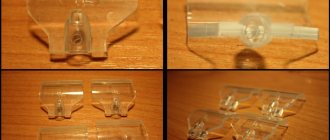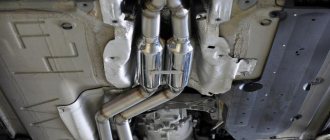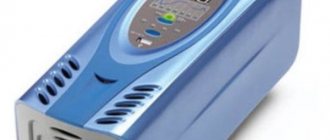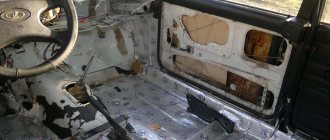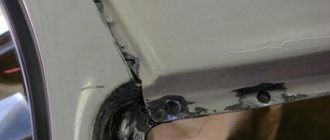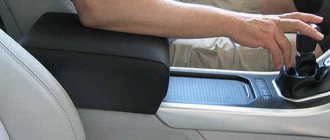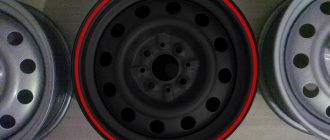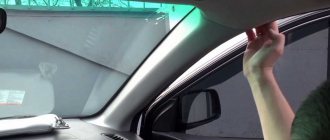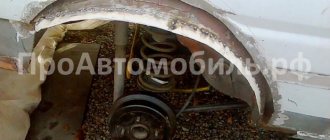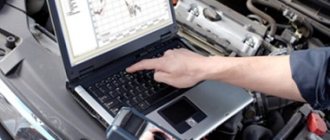The electrical equipment system of the VAZ 2114 car includes a whole range of different lighting devices.
It's good when it's light in the cabin
Conventionally, they can be divided into the following groups:
- Headlight;
- Tail lights;
- Lighting in the cabin.
To make it easier for the driver to navigate the road at night, halogen low and high beam lamps are installed in front of the car in the headlight unit. Turn signal lamps are also installed in one unit with them, so that when repairing the car the entire unit can be removed. At the rear there is one block on each side, which includes brake lights, turn lamps and reverse lamps.
How to make interior lighting yourself
The lighting of the lower part under the feet of the driver and passenger can be made neon, and the ceiling can be illuminated with LED lamps.
Neon lighting installation
First you need to install special emitters, for which you will need the following materials:
- nylon clamps;
- aluminum corner;
- neon emitters;
- self-tapping screws
Dismantling the lower part of the dashboard
You need to saw off a corner to fit the size of the emitter and screw it with self-tapping screws under the dashboard. The light should fall down directly under your feet. After this, you need to fix the emitter with clamps to the corner.
The same operation must be performed with all passenger seats in the car. On the rear seats, screw the corner with the edge up, protecting the emitter from mechanical damage.
Carefully lay all the wires under the floor and pull them out to the dashboard on the driver's side. If necessary, they must be extended and insulated at the connection points.
When connecting, the wires should be connected to the door opening sensor and the interior lighting switch so that when the door is opened and the lights are turned on, our additional lighting comes on.
Installing LED lighting
LED foot lighting in a car can be done according to a standard scheme, which is the same for all cars. To work you will need:
- heat-shrink tubing;
- wire cross-section 4x0.5 mm;
- LED strip and single diodes (you can take a ready-made factory-assembled strip like SMD 5050, but it costs more, so you can buy an RGB strip sold by the meter).
LED lighting kit
The backlight can be installed on the instrument panel, in the places of interior lamps and in those places where standard lighting elements are installed. You can replace all this with LEDs. Single LEDs have the same base as standard lamps, so if necessary, you can easily replace everything.
After this, you can determine where to install the backlight. Traditionally, it is installed in the foot area and along the perimeter of the roof along the racks. First you need to measure the required length of the tape and cut it to the required size.
The tape should only be cut in special places where solder contacts are located. The wire should be measured so that it is enough to reach the ignition switch (always allow some margin).
Cut, strip the ends and solder to the tape, and then stretch the heat-shrink tube and heat it with a regular household hair dryer or lighter until it shrinks.
Video:
The same should be done with other pieces of tape. After this, you need to remove the protective film from the back of the tape and glue the tape in the right place. All wires must be hidden under the pillar covers and brought under the dashboard on the driver's side.
Connection options:
- connect the container via RGB block;
- connection in the same way as neon lamps.
We described the second option above, but we will add that when connecting, you must be careful not to confuse the polarity indicated on the tape at the soldering points. When the do-it-yourself interior lighting is ready, you need to turn it on and check its functionality
When the DIY interior lighting is ready, you need to turn it on and check its functionality.
Connecting the backlight
There may be several connection options. Most often, LED lighting is connected to the cigarette lighter or to the interior light.
To connect to the interior lighting, you will need to remove the lampshade and connect the wires: positive is connected to white, negative is connected to red. If the connection is made through the cigarette lighter, then for this you will need to connect the plus to the plus of the cigarette lighter, and the minus to any place in the car body.
If you need to create a smooth ignition and switch-off effect for the LEDs, you will additionally need to connect a dimmer.
Neon lighting is connected a little differently. As a rule, it is powered from a battery through a specially installed transformer.
DIY car interior lighting
Restoring a car interior with your own hands
Under the feet of the driver and passenger, the lighting can be made neon, and the ceiling can be illuminated with LED lamps.
Installation of neon lighting. First of all, it is necessary to install special emitters, for which you will need:
- Nylon clamps;
- Aluminum corner;
- Neon emitters;
- Self-tapping screws;
We saw off a corner to fit the size of the emitter and light it with self-tapping screws under the dashboard. The light should fall down directly under your feet. After this, we fix the emitter with clamps to the corner.
We do the same with passenger seats. In the rear seats, we screw it with the edge up, which will protect the emitter from mechanical damage.
We carefully lay all the wires under the floor and pull them out to the dashboard on the driver’s side. If necessary, the wires at the connection points can be extended and insulated.
When connecting, the wires should be connected to the door opening sensor and the interior lighting switch so that when the door is opened and the lights are turned on, our additional lighting comes on.
Installation of LED lighting. Installation of LED lighting for the feet is carried out according to a standard scheme, which is almost the same for all cars.
But for work we need;
- Heat-shrink tubing;
- Wires (section 4x0.5 mm);
- LED strip and single diodes (you can take a ready-made factory-assembled strip like SMD 5050, but it costs more, so you can buy an RGB strip sold by the meter);
You can install backlighting on the instrument panel, in places for interior lamps, with standard lighting elements. All this can be replaced with LEDs. Single LEDs have the same base as standard lamps, and therefore, if necessary, they can be easily replaced.
Next, we decide on the location for installing the backlight. Traditionally, it is installed in the foot area and along the perimeter of the roof along the racks. First you need to measure the required length of the tape, then cut it to the required size. In this case, the mode is only in places with contacts for soldering.
The wire must be measured in such a way that it is enough to reach the ignition switch, but it is also recommended to provide some margin.
We cut off, strip the ends and solder to the tape, after which we stretch the heat-shrink tube and, using a household hair dryer or lighter, heat it until it shrinks. We should do exactly the same thing with other pieces of tape.
Next, we need to remove the protective film from the back side of the tape and glue it in the right place. We hide all the wires under the strut covers and place them under the dashboard on the driver’s side.
Connection options:
- connect the container via RGB block;
- connection in the same way as neon lamps.
We fix the lights and get acquainted with electrics
Since the main fault locations have been identified, you can safely move directly to methods for solving the problem. It is worth noting that with automotive electrics, not everything is so simple, but since this is a VAZ-2114, everything can be said very clearly here. Let's move on to methods for solving the problem.
Bulb
The first thing that needs to be checked is the lighting lamp, since its burnout can cause the light to go out in the car interior.
In order to get it out you will have to remove the lamp cover. After this, you need to check whether there is a filament, and insert the lamp into the control device or simply connect it to the battery. If the lamp lights up, then it is not the cause of the malfunction.
Ceiling lamp
More than once, the cause of the malfunction was the lamp itself, where the contact group simply melted and closed, which caused a burnout or a blown fuse.
To diagnose it, you will need to remove it from the car and visually inspect it. It is also recommended to ring the contacts going from the lamp to the wiring.
Fuse and relay for VAZ-2114
Replacing the fuse can solve the problem.
The next cause is a blown interior lighting fuse. This part can burn out due to a short circuit, which for various reasons occurs in the on-board circuit. Often the short circuit is caused by a malfunction of the lampshade.
The interior lighting relay is marked with an arrow. Often the contacts burn out and prevent the light from turning on.
Wiring
Broken wiring can cause a malfunction
Electrical wiring is the nightmare of any car enthusiast. For some, everything is clear, but for others, it’s a “dark forest.” So, during diagnostic operations, it is necessary to ring the wires going from the lampshade to the power supply or button.
conclusions
There are few reasons for the malfunction of the interior light in the VAZ-2114, and every novice car enthusiast will be able to determine the cause of the malfunction. It is worth remembering that if a car enthusiast is not sure that he can deal with the problem, then it is best to contact a car service center.
Didn't find the information you are looking for? on our forum.
We recommend reading:
Adjusting valves on VAZ 2101
Knock in the rear suspension, when driving over uneven surfaces, VAZ 2110
VAZ 2114 how to prepare for winter
VAZ 2106 revs drop when warming up
VAZ 2110 stalls while driving, 8-valve injector, possible causes and solutions
VAZ 2110 how to change a frog on a car, diagnostics and replacement
How to make a signal on a VAZ 2107
Which clutch is better to put on a VAZ 2115
Principles of approach to solving the problem
DIY car interior decoration
Before starting installation, it is worth understanding the task at hand:
choose a color scheme for the system that is harmonious in style; decide on the areas of space that you plan to attract attention to with the help of lighting; familiarize yourself with the interior diagram from the specifications for the car, and then clarify all the details directly on site; solve the issue with the principle of connecting the power supply.
Most often, the luminous line is attached to the dashboard, the lower contour of the seats, and on the doors. The entire path where the LED line is planned to be laid, namely: air ducts, armrest cavities, glove compartment, etc., must be examined, checked and cleaned of dirt, rust, and the like.
The laying plan is largely determined by the design of a particular car interior. The most popular LED backlight triggering schemes are:
The advantage of the first and second options is automation. The disadvantage is that there is no need for lighting during the day.
The LED line is powered by a line running under the floor and through the fuse box.
Installation of new equipment
Now let’s figure out how to install an LED lamp on a car; for this we will definitely need a VAZ 2114 interior lighting circuit. This is done in the following sequence:
- Remove the lampshade;
- Unscrew the base of the case;
- We connect the new lampshade;
- Screw the LED lamp into place.
First we need to remove the original lampshade and disconnect the wires from it, all the contacts, we also need to remove the diffuser. The housing is screwed to the roof sheathing with four self-tapping screws; they are simply unscrewed and the housing is removed. Next, you need to take a new case and connect all the plugs in accordance with the diagram to the contacts that go to the battery. The new housing is screwed in exactly the same way onto the same four self-tapping screws, and the lens is snapped into place.
In this simple way you can update your car interior and make the interior lighting of the VAZ 2114 more comfortable and convenient.
Neon is easy to install
How to dry clean a car interior with your own hands
Installing neon in a car is quite simple. Probably, this simplicity makes neon lighting much more popular than the LED version. They install neon almost anywhere in the car, and handymen do it even in places where it is impossible to imagine. For example, in the wheel arches or air intake, engine compartment, etc. Still, the most common place is the bottom of the car, where the lighting looks much better.
The video shows how to install neon car wheel lights:
The basic rule for installing neon lighting is the following: the farther the lighting is from the road surface, the better.
By placing the neon component under the bottom, you also get practical help. The road will be illuminated directly under the car. Needless to say, the connected neon lighting located on the bottom of the car will create an amazing appearance that is comparable to a car flying at speed. An even greater effect is achieved when racing along a snowy road.
In addition, neon electric lighting can also be used to transform the interior of a car, since the sizes of tubes on the market today vary widely.
The backlight is turned on directly from the network or through a switch. Some car neon samples are equipped with a special plug that can be easily connected to the cigarette lighter socket. This option is not always convenient, but it makes it possible to connect the backlight without interfering with the complex wiring of the car.
Experts and craftsmen recommend connecting neon lighting through the electrical supply system of the car, and installing the switch where it is most convenient.
The video shows what neon car headlights look like:
Install long tubes of neon lighting under the bottom of the car along the entire body, and short tubes under the edges of the rear and front bumpers.
As for multi-color backlights, they are always sold together with a special block. It also controls the modes, and also makes it possible to alternate different backlight colors or turn on the blinking mode. The most expensive models are also equipped with a special vibration sensor. It responds to vibrations from the car body and sound waves from the car's audio system. In this case, the strongest sounds will be given off by a stronger glow.
As for the backlight kit, you can assemble it either yourself, or by asking a specialist for help.
In addition to the usual neon lighting, there is also flexible neon, consisting of a flexible thin transparent tube with a diameter of two to five millimeters. It is customary to install such a pendant between interior panels, recreating a rather beautiful and cheerful design.
Having learned how to make neon lighting with your own hands, you can completely transform the appearance of your “iron horse”. This will no longer be just a car, but a work of art that will be a pleasure to drive.
What do you need to know about car interior lighting with cold neon?
You can add individuality to your car and make it stand out from the general flow of traffic using cold neon, which looks original and is very effective. Today, neon lighting is one of the most common methods of interior tuning. This option has the following advantages:
- minimal energy consumption. Neon is considered a practical option due to its long service life. Transparent material does not lose its original characteristics and does not fade. Despite its strength, it bends easily and cuts well when creating different light combinations;
- neon thread can be mounted in different parts of the car interior: on pedals, dashboard, door handles and/or glove compartment;
- cold neon does not distract the driver from monitoring the road situation and is considered a safe material for our vision;
- the light of flexible cold neon is distributed, evenly saturating the interior, which is very convenient in the dark and at night;
- When operating, do not turn on additional lighting devices, including standard equipment.
Do-it-yourself car interior lighting using cold neon is not only beautiful, but also practical. Such tuning allows you to protect you and your passengers, and provides a huge field for imagination. By making lighting in the car interior with your own hands, you can get a single-color light, or in different colors, using different patterns, colors and combining their quantities. Installation with neon material is a minimum cost and minor interference in the electrical system of the car, which does not affect the stable operation of other (standard) vehicle systems.
Neon is power, brightness and strength
Let's try to understand what neon variation is and how it differs from other types of lighting design. If we recall the famous Hollywood film “The Fast and the Furious,” then neon was used in its shots on cars. A gas-discharge lamp is used as a luminous element of the neon illumination system. It is placed in a special tube that protects the backlighting device from damage and various external influences, including moisture, dust, dirt and much more.
Thus, the neon component can give an unusual and incredibly bright glow. As for the diffuser, for neon options it is customary to use regular foil or a mirror, which do this job perfectly. Why is foil or a mirror used instead of a diffuser? Everything is very simple. This need arises due to the fact that a neon lamp shines in all directions, and most of it (if a diffuser is not used) will go nowhere.
Neon is usually used to illuminate the underside of a car. Neon electric illumination of the bottom can turn a car rushing along the road at night into something incredible and fabulous. Such a car can be compared to a bright, high-speed meteor.
In addition to neon, LEDs can also be used to illuminate the bottom. They will be discussed in detail below. Now I would just like to note that LEDs have their advantages and, compared to neon, they have strengths. In particular, this concerns the high strength and service life of LED structures.
Neon components have their advantages and disadvantages. We will return to the advantages later, but the disadvantage of such lamps concerns not only the mandatory installation of a diffuser, but also the inability to shine in different colors. In other words, for neon lighting, only one single color is selected, which becomes the main one. But it can be changed and it shines with attractive power.
Option No. 2. LED backlight powered by battery.
For installation you will need:
- LED strip for 2 contacts;
- a wire consisting of two cores, for example red and black, about 5 meters long;
- soldering iron and soldering material;
- sealant;
- toggle switch with “on” and “off” positions.
We cut the tape and wires as in the 1st option. We solder the wires to the contacts of the tape, each to its own pole indicated next to the contact. We solder the red wire to the positive contact of the tape, and the black wire to the negative contact. Terminal clamps can be used, or you can do without them. We already know how to use them. It is better to install them anyway, since in the future it will be easier to replace failed sections rather than changing the entire tape.
Then the black wire must be pulled to , stretching it under the carpet and trim of the car. We connect it to the battery. We connect the red wire to the toggle switch and then pull it to the positive terminal of the battery and connect it to it. We place the toggle switch in a convenient place where it is easy to reach with your hand. This backlight option will work as long as the toggle switch is in the “on” position.
Car interior lighting is an integral part of LED tuning. Every driver wants to make the car interior brighter and make their car stand out.
Motorists install cool wheels, low-profile tires, interior lighting, dashboard lighting, underbody lighting, and so on.
Standard incandescent light bulbs are a thing of the past, as are neon tubes; at the moment, LED lighting dominates, since the service life of LEDs exceeds 50 thousand hours, they do not drain the battery and shine brighter than conventional lamps.
The kits presented in our store are sold ready for installation and do not require installation at the service center; just stick the tapes on double-sided tape (included) and connect to the cigarette lighter.
Ready-made kits for car underbody lighting
A lighting kit can be assembled independently from individual elements, but it is more convenient, faster and easier to use ready-made industrial kits - they have almost everything you need, in addition, many of the models offered are highly functional and have many different modes. For example, a device with an RGB remote control with 252 LEDs illuminates the car in seven colors, is controlled from a distance of up to fifty meters, and provides up to 15 operating modes. This set consists of components:
- four flexible LED strips (2x90 and 2x120 cm);
- control unit;
- remote control;
- wiring for installation.
For RGB to work, a power supply of 12-15 Volts is required; the circuit implements such effects as running light, fading lights, variable and constant glow.
Foot lighting
If quite recently foot lighting could only be seen in luxury cars, today it is found even in budget models. Today, the market offers special kits for simplified installation, which include 4 lamps (for each seat) and a control panel. Installing the foot light is quite simple; all you need to do is follow these steps:
- Secure the elements with double-sided tape.
- Place the wires under the edges of the floor mats.
- Power the backlight from the cigarette lighter socket.
There are even simpler kits, consisting of simple lamps, without a control panel in the kit. Such lighting is less bright and durable, but cheaper (up to 500 rubles). There are also expensive sets on sale with the ability to control via Wi-Fi and change colors. Their cost is within 1500 rubles.
Installing LED car lighting
To tune the interior or trunk of a car, in addition to the LED strip, you will need plastic clamps. You can, of course, find a tape with adhesive on one side or attach it with double-sided tape, but this method of fastening is not the most reliable.
LED car interior lighting
Fastening with plastic ties is a bit of a mess, but more reliable. Connect the wires from the attached LED tubes to the power source. When connecting several LED strips, the main thing is not to confuse the polarity. To prevent this from happening, use wires of different colors for “+” and “-”.
The power source can be a car battery. Then the wires are routed under the hood. They are connected through a fuse, which is located next to the battery. A switch is usually built into the circuit. Place it where it is most convenient for you.
LED car underbody lighting
A good option for connecting LED lighting for a car’s interior may be to connect it to standard lighting. Then it will turn on/off along with the light in the cabin. LED lighting of car doors is done in a similar way.
Installing LED underbody lighting is practically no different from installing neon. You also need to attach corners or a profile to the bottom, lay an LED cord in it, and lead the wires from it to the power source. Just before the power source, a control unit is often installed that controls the intensity of the glow.
Vehicle underbody lighting control unit
For LED illumination of car wheels, the tape can be attached to the brake disc protective cover. The casing must be thoroughly cleaned, including rust. Then the surface needs to be degreased and then, after removing the protective strip, glue the LED strip. For reliability, you can drill the casing and pull clamps through the holes to secure the tape. But some wheel designs do not provide this opportunity. In this case, you need to make a frame from aluminum tape, which should preferably be placed behind the brake disc. Attach the ribbon to this frame. The junction of the tape and wires must be carefully sealed. It is advisable to use several types of insulation: first, heat-shrinkable tubing, then fill it with sealant, and wrap it all again with insulating tape.
LED illumination of car wheels
It is better to place the wires in a plastic corrugated hose, which is attached to the suspension arms next to the brake hoses with the same plastic clamps (do not pinch the hoses!). The power connection options are no different from connecting the interior lighting.
When using modern materials or ready-made kits, DIY car LED lighting should not cause any difficulties. You only need basic skills when working in electrical work, which every motorist with more or less decent experience has.
The video shows how you can modify the rear lights of a Kia Sportage 3 using LEDs.
https://youtube.com/watch?v=Cy8CinlJWNA
Main conclusions
Installation of car interior lighting is allowed if it does not create problems for other road users or the driver himself. The best option is to use LED lamps or strips; the easiest way is to purchase ready-made kits with a control panel. Illuminating the body from the outside is a more problematic procedure, which can be qualified as an unauthorized change in the composition of the vehicle's light alarm system. In such cases, you can lose your rights for six months or a year.
Previous
Car light The best H4 car lamps: review and selection tips
Next
Car lightSelecting and replacing a low beam lamp in a Volkswagen Polo
Do-it-yourself interior lighting algorithm of actions
The sequence of work consists of the following stages.
1. Cut the LED strip into pieces.
Produced with scissors in accordance with the intended length of sections (according to plan or location). The system cannot be divided everywhere, but only in certain areas. The landmarks of such areas are the yellow-brown rounded elements of the LEDs.
2. Strip the ends of the audio cable and irradiate each of the contacts on the red (“+”) and black (“-”) wires.
3. Connect the positive charge indicated on the light conductor tape to the red wire of the audio cable. Drizzle a mixture of liquefied rosin and tin on top. Do the same with the contacts of the black segment. After a few minutes of waiting, you need to check the strength of the connection.
When working, you need to be careful and watch to avoid errors like:
- polarities were reversed during installation;
- the edge of the spreading solder connected the “+” and “-” wires into a single whole.
4. At this stage of the work, a structure has been created, one end of which is a connection between a wire and an LED strip, and the other two are in a free state.
Next, connect the terminal block to the unused edge of the audio cable line in the traditional way.
5. Tear off the backing from the LED strip and stick it on a previously degreased area intended for installation. Make sure that the direction of the light flux is as planned.
To ensure secure fastening, apply a thin layer of “Moment” to the reverse side of the conductor line.
6. Observing polarity, use terminals to connect pieces of wires of the same color on the audio cable from different parts of the cabin.
7. Mark the installation location of the toggle switch (usually next to the control element for the alarm) and drill a hole.
To connect the button to the on-board power supply, select the necessary wires from the alarm system. Each of them is checked with a multimeter equipped with a sound signal function. Find two of them that trigger the buzzer. The stripped and tinned end of the red wire coming from the button is connected to a thick contact using pliers and then crimped with pliers.
The unused black wire is connected to the fuse box. From the electrical circuit located in the specifications for the car, pads that are not occupied by other devices are found. It is to them that the positively charged wire from the LED system is connected. The second option is to connect 2 wires to 1 contact (a current of 7.5 A is required).
8. Ground the system using the black wire and the round lug attached to it. The corresponding terminal is located next to the device for raising the car hood.
These are the main stages preceding the time when the interior lighting starts working normally.
Machine contour lighting
Contour lighting is one of the most expensive options when purchasing a new car. This type of lighting has a purely decorative effect. The appearance of the front panel, instrument panel and other interior elements, illuminated along the lines of the ribs and plane transitions, is very attractive and favorably emphasizes the interior trim. Luminous lines divide the interior into zones, separating sections of the dashboard, door trim, gearshift unit and other departments.
There are kits that can be installed in any brand of car. They are produced in the countries of Southeast Asia, so their price is affordable for any car owner. The standard kit consists of the following components:
- powerful LED;
- power driver;
- set of connecting wires;
- light guide
The LED is inserted into the end of the light guide, which fits into the joint lines of the dashboard panels or other interior trim elements. The driver power is connected to the side lights. Installation is not particularly difficult. In addition, you can choose the most preferred color of the LEDs, there are about 10 options in total. The cost of the kit depends on the length of the light guide (2-5 m), the presence of a wireless remote control and other design features. In any case, independent tuning will cost several times less than the standard option with which the car is equipped at the factory.
Neon lights and the law
Let us immediately make a reservation that Russian legislation has a very ambiguous interpretation of this issue. According to the Appendix to the Traffic Regulations, among the vehicle malfunctions for which its operation is prohibited, clause 3.1 is indicated. “The number, type, color, location and mode of operation of external lighting devices does not meet the design requirements of the vehicle.”
You can get a fine for changing the design of a car without the appropriate documents.
However, GOST R 51709-2001 does not indicate “underbody lighting” or something similar among the types of external lighting devices. You can receive a fine for changing the design of a car without the appropriate documents. Since you are unlikely to be able to obtain permission for such innovations, in this case you are violating Art. 12.5 part 1 of the Administrative Code. As a punishment, a warning or a fine of 500 rubles is possible. and equipment seizure.
ADVICE! Follow two simple rules, and it will be more difficult for traffic police inspectors to issue you tickets:
- Do not direct the light under the bottom to the sides, only down.
- Do not install blue and red lights in the radiator grille and bumper, or white neon in the rear. The red and white colors of the illumination should not extend beyond the front and back of the vehicle, respectively.
Direct the light under the bottom only downwards
Naturally, it will be much more difficult for the valiant law enforcement officers to find fault with the neon interior lighting.
Installing different lighting options
Point diodes
Do-it-yourself strut replacement: steps and step-by-step description of how to replace shock absorber struts (105 photos and videos)
A resistor is soldered to one of the legs of the diode. Next, solder the wires and wrap the exposed wiring with electrical tape. A terminal connection is made at a distance of about 20 cm. LEDs are ready for installation.
Now the installation site is being prepared. If we are talking about interior handles, then you will need to remove the trim and make a small hole at the installation site. The hole should be of such a diameter that the diode fits quite tightly in it. If desired, you can glue the diode with Moment glue.
The wiring is pulled under the trim into the interior so that it can be connected later. In the same way, point diodes are installed anywhere in the cabin.
LED Strip Light
Installing LED lighting in the car interior is not difficult. The location of the intended installation is measured and the tape is cut to the appropriate length. Incisions are made using scissors along special membranes.
ATTENTION! If you take more tape than necessary, it will not fasten well and will sag in the future. Therefore, it is better to cut a little less tape than planned
Wiring is soldered to the edges of the prepared sections, the functionality of the structure is checked by connecting it to power, and then proceed to installation. For the best adhesion of the tape to the plastic surface, the place where the tape is attached is degreased. To do this, apply the degreaser to a rag, wipe the desired area and leave it for 3-5 minutes until completely dry. After this, remove the protective film from the LED strip and glue the strip in the right place. If the tape does not have a protective film and a sticky surface, then “Moment” glue is required for its installation.
The algorithm described above is suitable for installing lighting on straight surfaces. If you need to install the backlight in an area with a bend, you will have to tinker. The fact is that it is not advisable to bend the LED strip even at an angle of 90 degrees. Therefore, you will need to cut two pieces of the required length, clean the edges and solder them at the folds. Place a heat-shrinkable tube over the soldering area and heat it up. Wiring is soldered to the outer edge of the LED strip, they are insulated and the strip is installed in the right place.
Neon lamps
Neon lamps should be installed in places where the risk of mechanical damage is reduced to zero. For example, to illuminate the engine compartment. For installation you will need the following tools and materials:
- neon lamps;
- aluminum corner;
- nylon clamps for fastening;
- self-tapping screws
If the lamp has a connector for connecting to the cigarette lighter, cut it off and clean the contacts. A piece is cut off from the aluminum corner, which matches the length of the lamp. The corner is screwed under the dashboard, and neon lamps are attached to it using clamps. In the same way, the lamps are mounted under the glove compartment and under the rear seats. The wiring is hidden under the car's skin and pulled to the dashboard.
Is underbody lighting allowed, fines in 2017
Fans of external tuning are concerned about whether underbody lighting is allowed on a car, and what the punishment will be if the rules are violated. In practice, traffic police inspectors quite often fine for homemade lighting, but their actions are not always lawful, and besides, the legislation does not clearly state what changes in the design of a car are offenses. Although LED or neon underbody lighting is not included in the standard lighting fixtures of a vehicle, nowhere in the traffic regulations is it stated that its use is prohibited
It is important here how lighting fixtures of different colors are located, since it is not allowed to install:
- in front - optical devices of any color except white, yellow and orange, and retroreflective elements should only be white;
- at the rear - any lights except yellow, red and orange; retroreflective elements here can only be red.
To illuminate the license plate, it is permissible to use only white lamps; in 2021, a fine for incorrect placement of light elements on the car body can be replaced by deprivation of the right to drive a car for up to 1.5 years. Many drivers know well where they cannot install light elements, so they place them according to the rules, but traffic police officers still find violations, because here they can interpret another article, for example, about unauthorized changes in the design of a car that are not registered with the traffic police.
As a rule, drivers get off with a warning or a fine of 500 rubles for installing underbody lighting. Much depends on the region, the pickiness of the traffic cops; in some places, inspectors do not pay attention to additional lighting elements.
When installing underbody lighting, the car owner should remember the important traffic regulations:
- lighting should not look like a signal given by a special service vehicle, for example, do not switch from blue to red;
- the light can only be located under the car itself, it is necessary that it does not extend beyond the dimensions of the car;
- Light rays must not be reflected from the road, and if they are reflected, they must match the acceptable colors in front and behind the vehicle.
As such, there is no fine in the rules for illuminating the underbody; however, drivers are often charged 500 rubles. for driving a vehicle that does not comply with GOST 8769-75.
conclusions
Thus, installing interior lighting with your own hands does not require special knowledge and skills. In order to do everything, you will need very little: materials, tools and a little patience.
When I was a beginner, when I didn’t even understand the basics, I really wanted to make my own lighting in the salon, but I didn’t know how. The eyes were afraid, but the hands did: first of all, I made blue LED lighting at the feet of those sitting in front. Then I decided to highlight the back ones as well. And then I realized that I was in a hurry. It was necessary to do both front and back at once. It's easier and more convenient.
This will be useful only for beginners, because... grandfathers know this business like the back of their hand.
The entire step-by-step action and a detailed description of them will be described here. How and what to tell sellers, how to use this or that tool, etc.
1. Determining the installation location of the LED strip.
First, decide what you want to highlight? Take a good look at these areas, whether it's the air vents, the glove compartment, or the engine compartment. Try to decide on the installation location of the LED strip (where exactly you will glue it). When illuminating the rear legs (and we are now looking at this example from my on-board vehicle), I glued tape under the seats, there is a plastic strip there, and I glued it to it.
2. We decide on connecting the backlight.
There are 3 options: for the light to turn on from a button, or for the light to turn on when the ignition is turned on, or for the light to turn on when something is opened (door, trunk). To turn on the light when you open something, you need a limit switch. But that’s not about that now. My advice is to make lighting in the cabin from a button, so that the light does not just light up during the day, but only lights up at night. Those. when necessary, turn it on. To do this, use the button. More on this later. So, we select the backlight from the button! Let's move on.
3. Choose the color of the ribbon.
It is very important that the color harmonizes with the surrounding colors. After all, the result and quality of the glow depend on this. I chose blue. Have you decided on a color? Great. Let's go buy materials.
4. Purchase of materials.
We will need:
- Passatizhi. You can buy at Maxidom - Soldering iron for 220v. It can be bought at any radio store or Maxidom.
- Tin and rosin. You can buy it there at the radio engineering store. (You can buy tin in the form of a pebble or there is a liquid that replaces rosin.)
- Utility knife. You can buy it at Maxidom.
- Terminal block. We will fix the wires in the terminals. Otherwise, you can get away with using regular twisted wire terminals (you just twist the wires together), but twisting is not a reliable connection for safety reasons. But we do it conscientiously! This is why we buy terminals. These terminals can be bought, for example, at Maxidom. Terminals are selected for a specific wire cross-section. Take 1mm square or 1.5mm square, this is quite enough. The terminal block looks like this:
You also need a couple of terminals with round contacts. They can be bought at any radio store.
— Contacts for connecting wires to the button. They look exactly like this: Like this
There are the same ones, only a little smaller
We need both. For the first time, take 10 pieces of those and 10 pieces of others. We'll need them. There are also isolated and non-isolated contacts. That red crap on the contacts is insulation. It’s better to buy insulated ones, of course. Tell the seller to give you isolated contacts. if not, take regular ones.
- Button. You can buy any button. For example, this (toggle switch): fiv
Or any other that is fixed in a pressed position. For example, an Emergency button (I have exactly this one installed to illuminate my legs; you can look at it on your avatar or in the blog.) In general, a button that is fixed in position.
- Cable. You can buy an acoustic cable with a 1mm square cross-section. The cable consists of 2 copper wires, one of the wires with black insulation, the other with red insulation. Those. We come, for example, to Maxidom and ask if we need a 1mm square speaker cable. Take 10 meters, just in case).
- Well, glue. You can buy “Moment” glue. Any. You can even waterproof).
— Indicator. It serves to detect positive on any contact. More on this later. It costs about 100 rubles. You can buy such a miracle at BI-BI or at any other automobile store. It's called "Indicator".
- Multimeter. It’s better to take the one that “squeaks”. Here’s one, for example (the cheapest but suitable for working on cars and renovating an apartment)
Or one that doesn’t beep, for example this one:
To select the one that is reading, on the multimeter (hereinafter referred to as the cartoon), at the bottom of the round switch, a little to the right of the value “200” a picture with a dot will be drawn and to the right of the dot there are three arcs, like emoticons “)))”. This cartoon squeaks. (We’ll find out what the beeping is later). Another cartoon, also to the left of the value “200” a diode will be drawn. It is depicted as a cross and at the bottom of the cross there is a triangle painted in black. This cartoon doesn't squeak. In this case, we need a multimeter to test the wires and contacts of the button. How we will use it - more on that later.
— Heat shrink and electrical tape. Heat shrink is used to insulate bare contacts and wires from contact with other contacts and wires - this is necessary for protection against short circuits, etc. The heat shrink looks like a tube. Its colors are different. Buy a thin tube (one tube will be enough) so that our “contacts” fit into it. The cost of the tube is from 20-50 rubles. You can buy it at maxidom or radio store.
— Well, the LED strip itself. I HIGHLY do not recommend buying it from Maxidom. There the prices for it are just fucking high! Something like 600 rubles per half meter! In normal stores, tapes are sold from 200 rubles per half meter, well, a maximum of 300 rubles. The tape can be bought at any store that sells car wires, light bulbs and all sorts of toys for cars sparkling with different lights. In general, in any store that sells light tuning. We buy as many meters of tape as you need. Choose the color to your taste. He buys the tape in a casing. It is easy to distinguish between a tape with and without a sheath. Without the shell, you can touch the LEDs on the strip with your fingers. It won’t work with a shell) the tape will be in the shell). That's what we do - we go up to the seller and say - I need an LED strip of this color and so many meters in a silicone or any other shell. The main thing is in the shell. Then he himself will give you what you need.
That's all! We bought everything we needed! Now you're wondering where exactly to connect the wires? Are you indignant? Do not be afraid. I myself was afraid of burning something the first time. But now it’s not about connection.
5. We cut the tape.
Now, to highlight the hind legs, we measure the place where we will glue the tape. And we cut the same distance on the tape. There will be these yellow-brown rounds or ovals on the tape - cut strictly according to them! Cut with scissors Cut off.
And we cut the same distance on the tape. There will be these yellow-brown rounds or ovals on the tape - cut strictly according to them! Cut with scissors Cut off.
6. Preparing to connect
We take a soldering iron in our hands) Heat it. Next we put rosin or the liquid that we bought, and tin. Take the cable and cut it 30-40cm. For one piece of tape - one cable, i.e. 2 wires - one black, the other red. I see, right? For one piece of tape, one black wire is 30-40cm and one red wire is 30-40cm. We take the cutter's bottom and carefully strip the wire about 10 centimeters, no more and no less. Well, maybe a little less. Then we take a soldering iron and poke it into the rosin. poke it well. Then a little on the tin - you should get some kind of mixture of rosin and tin. Then we bring the soldering iron to the wire and run the soldering iron along this cleaned wire. Our copper wire should become the color of tin, even a little brown. There is no need to spend a long time using a hot soldering iron over the wire. In a quick way - chick-chick on both sides of the wire and that’s it. Now you have just tinned the wire. Further on the tape, these yellow pimples are the contacts of the tape. Where there is a plus there is a plus, where there is a minus there is a minus. obviously) The colors of the wires are black minus, red plus. Everything is clear here. We connect minus with minus, plus with plus. Those. We solder the red wire to the plus, and the black wire to the minus. Don't get confused. So, again we take rosin to the soldering iron (do not spare rosin) and tin (so that there is a small drop of tin on the soldering iron), in the other hand we take the wire, bring our tinned wire to the contacts of the tape, connect the contact of the tape with the wire and drop this drop of ours onto wire and contact. All. There’s no need to linger there for a long time either. Dropped and that's enough. Make sure that the droplet does not touch the negative contact! So, let's look - the contact must be strong. Allow the contact to cool for 10 seconds. Blow on it. Next, try slightly (SLIGHTLY!) pulling and tugging on the wire. if it doesn’t come off - ZBS! We continue to solder the remaining wires at this pace. If you don’t know how to solder, you can watch a training video on YouTube or VK. Wherever is convenient for you. So. We have two wires, two pieces of tape. One end of the wire is soldered to the tape, the other end of the wire remains free. We put our terminal blocks that we bought on these free ends. You'll need a screwdriver here. Everything is simple here - unscrew it, insert the wire and tighten it. The contact is quite strong. So we made something like this: A tape to which wires are soldered, at the ends of which there are terminals. It looks like this:
Execution technique
The whole process is quite simple, you only need some materials and school knowledge in electrical engineering:
- Purchase a plastic mounting box used for electrical wiring. At a radio equipment store, buy LEDs based on taste and color, and also purchase a 700-800 Ohm resistor. You can also purchase ready-made neon pipes.
- Mark the location points of the LEDs on the box (the best option would be a distance of about 5 centimeters). Connect the resistor, and do not forget to check the bulbs for functionality by first connecting them to the battery.
- Place the LEDs along the holes and connect them in parallel. Shorten the top part of the LEDs (otherwise you will see not a stream of uniform light, but luminous points), and also seal the edges of the box with sealant.
- Secure the box to the bottom using clamps, which must be attached to the body using self-tapping screws. You can avoid using a clamp by securing the box directly to the bottom. Be sure to install a transformer block under the hood of the car to which you want to connect the leads from the LEDs.
- In the car interior, install a separate switch responsible for the backlight operation. Install it in any convenient and easily accessible place. Connect the toggle switch to the transformer wires, and connect the finished circuit to the vehicle's power supply system.
This is just one way to illuminate the floor of a car. There are others, no less original and not expensive.
Why the light in the cabin does not light (main reasons)
Car interior lighting is part of the electrical system, and therefore, in any case, it is worth looking for the problem in this part of the car. Of course, it is recommended to study, at least superficially, technical electrical diagrams in order to be at least a little up to date.
So, what do you need? A detailed diagram of the car's electrical components, a little ingenuity and a minimal set of tools. Let's look at places where the problem may be hiding:
- Bulb.
- Ceiling lamp.
- Fuse.
- Wiring.
We fix the lights and get acquainted with electrics
Since the main fault locations have been identified, you can safely move directly to methods for solving the problem. It is worth noting that with automotive electrics, not everything is so simple, but since this is a VAZ-2114, everything can be said very clearly here. Let's move on to methods for solving the problem.
Bulb
The first thing you need to check is the lighting lamp, since its burnout can cause the light to go out in the car interior.
In order to get it out you will have to remove the lamp cover. After this, you need to check whether there is a filament, and insert the lamp into the control device or simply connect it to the battery. If the lamp lights up, then it is not the cause of the malfunction.
Ceiling lamp
More than once, the cause of the malfunction was the lamp itself, where the contact group simply melted and closed, which caused a burnout or a blown fuse.
To diagnose it, you will need to remove it from the car and visually inspect it. It is also recommended to ring the contacts going from the lamp to the wiring.
Fuse and relay for VAZ-2114
The next reason is a blown interior lighting fuse. This part can burn out due to a short circuit, which for various reasons occurs in the on-board circuit. Often the short circuit is caused by a malfunction of the lampshade.
Wiring
Electrical wiring is every car enthusiast's nightmare. For some, everything is clear, but for others, it’s a “dark forest.” So, during diagnostic operations, it is necessary to ring the wires going from the lampshade to the power supply or button.
Why illuminate the underbody of a car?
In fact, the luminous bottom of the car does not provide any practical benefit. Perhaps you can quickly find a dropped phone, keys or other small items. The main purpose of the glowing bottom of the car is to attract the attention of others and spend some time as a creative car designer, admiring the work of your own hands.
There are also some downsides here - the luminous car does not go unnoticed by the traffic police. Believe me, they will definitely stop you to check your documents and ask a couple of questions.
Installing the backlight without violating the rules gives you the full right to use the car without fear of losing your license or running into a fine.
Backlight options
The modern car accessories market offers two lighting options: neon and LED. These lighting options are installed either separately or combined with each other, illuminating part of the interior with neon and part with LEDs.
Neon lighting is found in the form of lamps or flexible cord. The lamps emit bright, even light, but are susceptible to mechanical damage and often burn out with intensive use. Flexible tape is more practical, it is easily installed in the car, is suitable for illuminating uneven and embossed surfaces, does not break and consumes little electricity.
LED backlighting is becoming increasingly popular, which has the following advantages:
- flexible design;
- compact dimensions;
- ease of installation;
- convenient form of purchase (by footage);
- low sensitivity to mechanical damage;
- increased service life;
- the ability to change the color of the light flux (in RGB strips).
Thanks to its compact size, the LED strip can be glued to small interior elements: handles, cigarette lighter, steering wheel trim. With its help, you can get interesting lighting effects, ranging from smooth switching on and off of the backlight, ending with transitions between several colors.
IMPORTANT! The color of the lighting should be in harmony with the color of the interior. The result and quality of the glow depend on the correct choice of color.
Installation materials
To equip a car with LED lighting with remote control you will need:
- Self-tapping screws for metal.
- LED strip with protection of at least IP65.
- Ties measuring 2.5x100 mm.
- Control unit with remote adjustment.
- Silicone tube.
- Screwdrivers, soldering iron, drill.
- Heat-shrink tubing.
- Perforated L-shaped building profile.
- Beacons for leveling floors.
- Aluminum corner.
- Multicore cables with copper wire and double insulation 0.75-1 mm.
Nuances during operation
When operating a car with an illuminated bottom, traffic police inspectors may ask you questions. In the DD rules, lighting acts as a prohibited lighting device. Adjust its light so that it is not too bright and does not distract the attention of other drivers on the road. To do this, contact an experienced lawyer, car service specialists, or independently study the material available on these issues.
